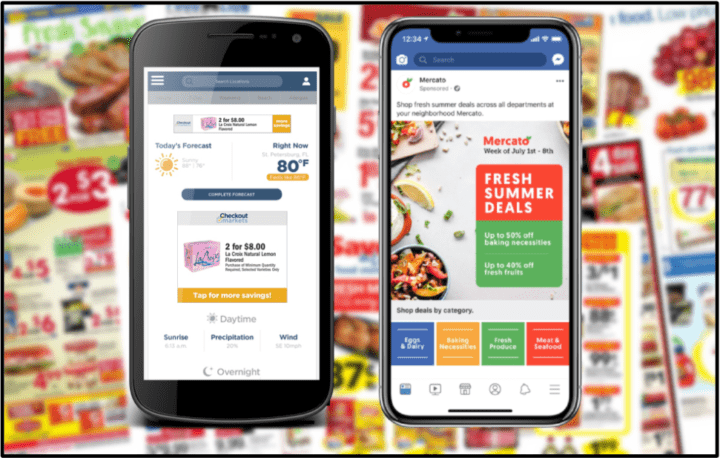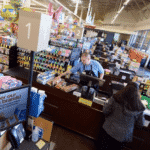
Not that long ago, publishing a “digital circular” used to mean posting a PDF of the printed ad online and calling it a day. Since then, retailers’ digital weekly ads have gotten more advanced – they’ve become searchable, clickable and sortable. Now, the latest trend is a weekly ad that you don’t have to go looking for online – because it will come to you instead.
Catalina, most famous for its coupons that print alongside your receipt at the checkout, is the latest to introduce a new personalized digital circular that will let you know about the best grocery deals of the week that are most likely to interest you, before you had even thought about planning your grocery list that week.
If you’ve ever browsed for a product online, then started seeing ads for that product show up on other websites you visit, you’ll get how Catalina’s Digital Circular Personalizer (otherwise known as Digital CircP) works. The Digital CircP will show up in the form of banner ads on popular websites like weather.com, usatoday.com, allrecipes.com and more, featuring the top five items on sale that week that are most likely to spark your interest.
Catalina will use its database of shopper history and other “unparalleled personalization capabilities” to identify the items most likely to be on your shopping list. If you click on the banner, you’ll be provided with a more extensive list of about two dozen recommended sale items, which you can save to a mobile wallet for easy reference when you’re ready to head to the store to pick up your bargains.
“Circulars have served us well over the years,” but Digital CircP “takes it to the next level by delivering relevant, hyper-personalized offers to loyal and prospective customers alike wherever and however they access the web,” Stop & Shop’s Rachel Stephens, Vice President of Marketing, Digital and Loyalty, said in a statement, after a test run of Catalina’s new offering.
Not to be outdone, Coupons.com owner Quotient Technology recently introduced its own version of a digital circular. Its “promotion amplification tool” also highlights items on sale during any given week, via targeted online banners. Quotient says its data shows that brands run more than 2,000 promotions in grocery stores each week, but only about 10% are featured in the stores’ printed weekly circulars. “This means that shoppers may not be aware of many on-sale items available to them,” Quotient explained.
Using its own data, and insight into your shopping habits gleaned from retailers’ loyalty programs, Quotient’s system will target you with online ads featuring items you’re likely to buy, particularly if you didn’t even know they were on sale at your local store that week. “This capability allowed us to reach shoppers digitally and notify them of an existing sale when the product might not have made the weekly ad or email,” David Li, Associate Shopper Marketing Manager at PepsiCo, said in a statement, after participating in a test of the new tool.
And if you’re more likely to spend your time on social media than on traditional ad-supported websites, there’s Stitcherads. The marketing company recently introduced “Digital Circulars and Catalogs,” which allows grocery retailers to feature personalized product recommendations from their weekly ad, while you’re browsing Facebook, Instagram or Pinterest.
In addition to featuring only sale items that are relevant to you, Stitcherads’ system can access live data feeds of product availability in stores, to ensure it’s not promoting an item that’s already sold out at your local store.
Retailers have been talking about retiring expensive and inefficient printed weekly circular programs for years. And during the coronavirus pandemic, a few finally went ahead and did it. But any retailer that pulls the plug on printed weekly ads had better be sure their digital ad is easy to find, easy to navigate, and generates sales. And that’s where companies like Catalina, Quotient and StitcherAds hope they can come in.
“For decades, the average family has received a plethora of paper circulars in their mailbox or newspaper every week from multiple grocery, mass, and specialty retailers,” Catalina said. But “traditional paper circulars no longer generate the shopping trips and return on investment they once did.”
“Circulation has declined for years and… the cost of print has increased.” StitcherAds CEO Declan Kennedy noted. “We’re solving these problems by making it easy to transform localized print circulars into digital, personalized experiences.”
Temporary price reductions are “more easily accessible digitally,” Quotient CEO Steven Boal explained. “Our new promotion amplification tool provides consumers with increased access to savings, delivering more value at a time when many need it most.”
So if you’ve stopped receiving a printed weekly ad from your favorite store, or just don’t want to go through the hassle of looking for one, it’s still possible to take advantage of weekly sales just like you used to. The only difference is, you’re more likely now to find them online – that is, if the deals don’t find you online first.











I’ve come to the conclusion that all these CEOs of digital media, coupons providers, and any other idiot in the development of digital deals just spew. BS out of their mouths trying to convince the population that digital everything is the ultimate answer to your need to help your family stretch the almighty dollar. Not only are they totally pushing digital for their own gain, they fail to address digital coupon issues that arise at almost every transaction. People are fed up with coupons that don’t load, promised discounts that magically do not apply to your purchase because of what ever reason they come up with, or the fact that with every iOS or Android update devices are becoming outdated requiring people to spend yet even more money just to access the lates and greatest update among the few apps that still offer discounts, rebates, etc. At what point do we the consumers realize that there is not real saving anymore. It’s just a cycle of redistributing your funds elsewhere. Recently Ibotta updated there app excluding any device that doesn’t use Apple iOS 13 or above. As a result, now 2 devices I use to save money no longer work. Apple iPad 4th gen cost me over $2,000.00 years ago and iPad mini 1st gen was a $1,000.00. Both still run, just not for any app that utilizes rebates, coupon printing, or any options available to save on groceries. So I guess I’m supposed to spend the money I saved on new devices. How is that an actual saving scenario? I’m just spending grocery money on new technology that is purely developed for the purpose of future sales. Apple could give two shits about my families financial security. They only care about sales. Goggle and Amazon aren’t any better. Samsung has a special place in hell as far as I’m concerned. They don’t stand behind anything they manufacture, lie to you about service as well as your Warrenty. I’m out over $6K for a Samsung refrigerator and stove that have not worked from day one. Samsung’s excuse was the closest tech service was located in Texas. I live in Pa. So guess what, no return, refund, or support and once you call your local tech, if your lucky enough to find on, your Warrenty is void. Now that I’ve gotten off topic so of, end game is that you can continue to believe that you are saving via digital and live the lie that technology is your friend, or start pushing back. Ive boycotted all Samsung, Ibotta has been deleted and deactivated, Apple is next on the list. Are you really saving any money at all? Last word, Walmart is not your friend. Since coupons/ rebate apps have become hot topics, Walmart’s response has been to increase prices of items with a high value coupon in circulation, increases are identical or close to the coupon/ rebate value . An other strategy I’ve repeatedly posted about is the removal of items from stock until coupons are void. I’ve tracked this behavior for 18 months and have always observed the exact same results on items having high value coupons. Do you really think that Suave raised their prices for baby shampoo/ body wash $1.50. Magically went from $1.88 to $3.49 over night when the $1.50 coupon was in circulation. We’re not saving anything, just presented the illusion that we are.
I think Coupons In The News should do a Top 10 Replies of the Year at the end of 2021, similar to how you do the Top 10 stories of the year. I’d hereby like to nominate Bonnie’s response for the Top 10! That was a truly epic rant, I agree with most of it, and I’m an….honest couponer!